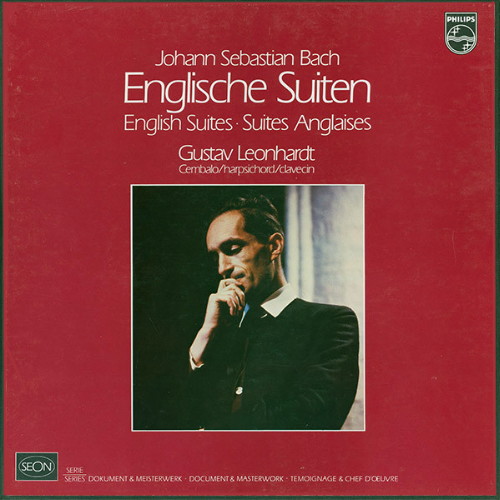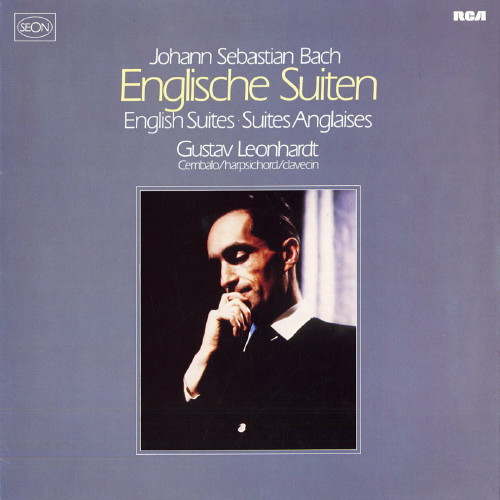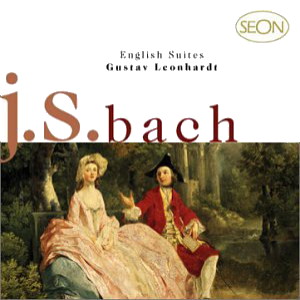 |
3 LPs
- 6776 001 - (p) 1974
|
 |
1 LP -
RL 30811 - (p) 1982
|
 |
| 2 CDs -
SB2K 62949 - (c) 1997 |
|
ENGLISCHE
SUITEN
|
|
|
|
|
|
|
|
| Johann Sebastian
BACH (1685-1750) |
Suite
No. 1 in A Major, BWV 806 |
|
24' 23" |
|
|
-
Prélude |
2' 09" |
|
A1
|
|
-
Allemande |
5' 36" |
|
A2 |
|
-
Courante I - II avec deux doubles
|
6' 47" |
|
A3 |
|
-
Sarabande |
3' 11" |
|
A4 |
|
-
Bourrée I - II
|
3' 47" |
|
A5 |
|
-
Gigue |
2' 53" |
|
A6 |
|
Suite No. 2 in A minor, BWV
807
|
|
22' 25" |
|
|
-
Prélude |
5' 27" |
|
B1 |
|
-
Allemande |
4' 32" |
|
B2 |
|
-
Courante |
2' 06" |
|
B3 |
|
-
Sarabande |
3' 53" |
|
B4 |
|
-
Bourrée I - II |
3' 51" |
|
B5 |
|
-
Gigue |
2' 36" |
|
B6 |
|
Suite
No. 3 in G Minor, BWV 808
|
|
20' 56" |
|
|
-
Prélude |
3' 37" |
|
C1 |
|
-
Allemande |
4' 34" |
|
C2 |
|
-
Courante |
2' 38" |
|
C3 |
|
-
Sarabande |
3' 42" |
|
C4 |
|
-
Gavotte I - II (ou la Musette)
|
3' 14" |
|
C5 |
|
-
Gigue |
3' 11" |
|
C6 |
|
Suite
No. 4 in F Major, BWV 809 |
|
22' 47" |
|
|
-
Prélude |
5' 27" |
|
D1 |
|
-
Allemande |
4' 22" |
|
D2 |
|
-
Courante |
1' 59" |
|
D3 |
|
-
Sarabande |
3' 27" |
|
D4 |
|
-
Menuet I- II
|
3' 52" |
|
D5 |
|
-
Gigue |
3' 40" |
|
D6 |
|
Suite
No. 5 in E Minor, BWV 810 |
|
24' 24" |
|
|
-
Prélude |
5' 56" |
|
E1 |
|
-
Allemande |
5' 07" |
|
E2 |
|
-
Courante |
2' 51" |
|
E3 |
|
-
Sarabande |
4' 00" |
|
E4 |
|
-
Passepied I (en Rondeai) - II
|
3' 14" |
|
E5 |
|
-
Gigue |
3' 16" |
|
E6 |
|
Suite
No. 6 in D Minor, BWV 811 |
|
28' 30" |
|
|
-
Prélude - Allegro
|
8' 35" |
|
F1 |
|
-
Allemande |
5' 08" |
|
F2 |
|
-
Courante |
2' 40" |
|
F3 |
|
-
Sarabande - Double
|
3' 59" |
|
F4 |
|
-
Gavotte I - Gavotte II
|
4' 01" |
|
F5 |
|
-
Gigue |
4' 07" |
|
F6 |
|
|
|
|
|
| Gustav
Leonhardt, Harpsichord by Martin
Skowroneck, Bremen, after J. D. Duclken,
Antwerpen 1745 |
|
|
|
|
|
Luogo
e data di registrazione |
|
Doopsgezinde Kerk,
Amsterdam (Holland) - Settembre
1973
|
|
|
Registrazione: live
/ studio |
|
studio |
|
|
Producer /
Recording Supervisor |
|
Wolf Erichson
|
|
|
Recording Engineer
|
|
Dieter Thomsen
|
|
|
Prima Edizione LP |
|
Seon (Philips) | 6776
018 | 3 LPs - durata 45' 23" - 43'
43" - 52' 54" | (p) 1974 | ANA
Seon (RCA Red Seal) | RL 30811 | 1
LP - durata 46' 48" | (p) 1982 |
ANA | (BWV 806 & 807)
|
|
|
Edizione CD |
|
Sony | SB2K 62949 | 2
CDs - durata 68' 08" & 76' 02"
| (c) 1997 | ADD
|
|
|
Original Cover
|
|
-
|
|
|
Note |
|
-
|
|
|
|
|
It is not
entirely known hovv the six
superb harpsichord pieces
included on this recording
came to be called "English
Suites." Johann Sebastian
Bach himself merely
described them as "Suites
with prelude." His first
biographer, Johann Forkel,
said, “they are known as the
English Suites because the
composer wrote them for an
Englishman of rank" - but no
such British nobleman has
ever been identified.
Authentic or not, however,
the name "English" is quite
useful, for it distinguishes
this set from two other Bach
keyboard collections: the
smaller French Suites, and
the still larger Partitas.
Few if any listeners think
that the absence of English
musical characteristics in
these splendid works is a
defect.
Remaining unpublished during
Bach's lifetime, the English
Suites were probably written
around 1722, when Bach was
still Kapellmeister
at Cöthen but already
looking for another
position. That year, Bach
finished Volume I of his
titanic Well-Tempered
Clavier; his
comprehensive Clavierübung
collection - containing the
Partitas, the Italian
Concerto, etc. - still
lay in the future.
In performance, the English
Suites are heard less often
than the six French Suites
or the six Partitas. They
suffer, in effect, the fate
of a "middle child," being
more difficult than the
French group but less
extended and, perhaps, less
showy than the equally
challenging Partitas.
Nevertheless, their artistic
conception places them
absolutely on a par with the
other two collections.
Bach's own designation for
the English Suites may have
been laconic, but it
identified their most
important distinction: the
effect of their preludes.
The Baroque suite, in its
simplest form, was merely a
string of dances, sometimes
preceded by a brief
introduction. A large
complex prelude, however,
lent a far more substantial
character to a suite, making
it comparable to the most
ambitious orchestral pieces
of the era. This is
emphatically true of Bach's
English Suites, for here the
preludes are unprecedented
in size and weight -
considerably bigger than
similar suite-introductions
by Krieger, Kuhnau and
Handel. Indeed, the opening
movement of Bach's G-minor
English Suite is so
voluminous that it threatens
to burst the bounds of the
form. And although the
Prelude in Suite No.1 is
rather brief, three of the
others (in Suites Nos. 2, 5
and 6) are elaborate
aria-like pieces, while the
Preludes in G minor (No. 3)
and F major (No. 4) are huge
concerto-style movements
that virtually transform the
harpsichord into a full
orchestra with soloist.
Following the prelude, four
specific dances almost
always appear in Bach
suites. First of these is
the allemande, a 4/4 dance
in "walking" tempo. In the
ballroom, its steps and
motions included
handkerchief gestures, which
Bach sometimes evokes with
undulating or fluttering
figurations. Next come two
dances in triple time: the
courante (fast, vigorous,
and rhythmically intricate)
and the sarabande (very
slow, courtly and even
majestic, with a subtle
accent on the second beat).
For a finale, Bach generally
provides an animated gigue
(jig). Between the sarabande
and the gigue, smaller
dances (called galanteries)
may be inserted.
Perhaps nothing better
proves Bach's supreme
instinct for balance than
the fact that these dance
movements in the English
Suites hold their own
against the monumental
preludes. The allemandes
embody the style of free
improvisation in their arpeggio-like
figures and contrapuntal
ingenuity, and the courantes
follow the richly decorated
French taste. In the
sarabandes, the original
character of the solemn
dance is still recognizable,
while the gigues mostly
follow a strict fugal style,
providing endings to the
Suites that combine
intellectual substance with
the liveliest energy. The
second Gigue (A minor) is
something of an exception,
forgoing fugal writing in
favor of a smooth Italianate
web of sound.
Variety abounds in Bach's
treatment of these dances.
The "package" of four
Courantes in No.1 (i.e.,
there are two Courantes,
each with a variation, or Double)
follows the French model,
agglomerating dance
movements of similar
character - a practice
probably intended to allow
the performer freedom of
choice. Bach infuses the
G-minor Suite with intense
and abrupt contrasts,
juxtaposing the graceful
Gavotte-cum-Musette
with a passionate Gigue. His
rich and provocative
chromatic harmony in the
E-minor Gigue reveals a
close affinity with many
other Bach keyboard and
organ works in the same key.
The closing Suite, in D
minor, is full of meditative
seriousness, its somber
atmosphere intensified into
demonic passion by its last
movement - probably the most
technically difficult Gigue
in the series.
Jay
M. Balenkof
These
notes are based on those
by Lothar
Hoffmann-Erbrecht, which
accompanied the original
1974 release.
|
  |
|
|